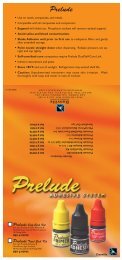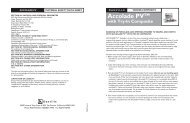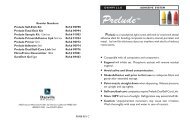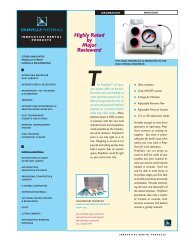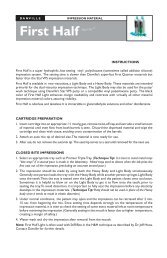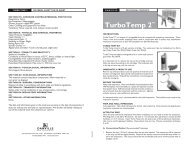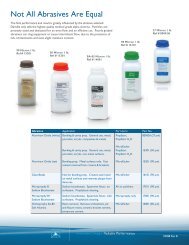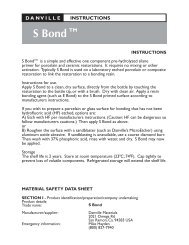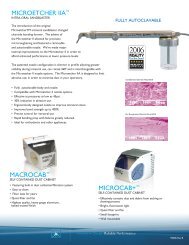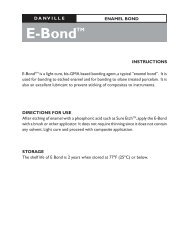StarFill2B Tech - Product Sheet.pdf - Danville Materials
StarFill2B Tech - Product Sheet.pdf - Danville Materials
StarFill2B Tech - Product Sheet.pdf - Danville Materials
Create successful ePaper yourself
Turn your PDF publications into a flip-book with our unique Google optimized e-Paper software.
JANUARY 1998STAR FILL 2B<strong>Tech</strong>nique ArticleTHE DIRECTED SHRINKAGETECHNIQUE FOR POSTERIORCOMPOSITE PLACEMENTby Raymond Bertolotti, DDS, PhDRAYMOND BERTOLOTTIDDS, PhD, FADMSTARFILL 2B TMSPECIFICALLY DEVELOPED FORTHE DIRECTED SHRINKAGETECHNIQUE OF POSTERIORCOMPOSITE PLACEMENT.IT IS A DENTIN SHADED, RADI-OPAQUE, FLUORIDE RELEASING,DUAL CURED, STRONG, FLOW-ABLE, MICROHYBRID COMPOS-ITE.During light curing of composites,it is well known that light initiated polymerizationtends to pull composite toward thelight and away from the composite-toothinterface (Figure 1).FIGURE 1In the “Directed Shrinkage” technique forcomposite placement 1,2,3 , the compositepolymerization is initiated by the bondingagent in the prepared cavity. The polymerizationshrinkage is initially directed towardthe tooth-composite interface (Figure 2).This initially polymerized layer resists thefurther tendency for the composite to pullaway from the interface, influenced bylight curing.FIGURE 2Chemical cure is generally the preferredmode of cure for the initial stages of polymerization.A reduced rate of cure 4 reduces is a dentin shaded, radiopaque, fluoridestress in the composite and results in better releasing, dual cured, strong, flowable, microhybridcomposite. StarFill 2B is allowedmargins. However, dual cure is generallybelieved to result in better polymerization to cure in the chemical cure mode until itand enhanced properties.is substantially cured, then light cured foradditional polymerization.StarFill 2B was specifically developed forthe directed shrinkage technique of posteriorcomposite placement. ItStarFill 2B may be lightWhen directed shrinkage is not required,1 Bertolotti R.L. PP&A Aesthetic Chronicle 1991; 3, 53-58.2 Ferrari M. PP&A Aesthetic Chronicle 1993; 5, 29-36.3 Garberoglio R. et al. Am J Dent 1995; 8, 303-307.4 Mehl A. et al. J Dent 1997; 25, 321-330.DANVILLE MATERIALS SAN RAMON, CALIFORNIA 94583 PHONE 925/973-0710 FAX 925/973-0764 1-800-827-7940
<strong>Tech</strong>nique ArticleTHE DIRECTED SHRINKAGE TECHNIQUE FORPOSTERIOR COMPOSITE PLACEMENTBY R. L. BERTOLOTTI, DDS, PhDTHE DIRECTEDSHRINKAGETECHNIQUEFIGURE 3 FIGURE 4FIGURE 5FIGURE 6FIGURE 7 FIGURE 8 FIGURE 9FIGURE 10 FIGURE 11 FIGURE 12 FIGURE 13123cured immediately after placement.It may be used for applications suchas post and core when no light cureis possible.THE DIRECTED SHRINKAGETECHNIQUEA typical tooth “before” restorationis shown in Figure 3.Cut prep, using <strong>Danville</strong>’s CariesFinder TM as a guide to cariesremoval (Figure 4).Etch enamel and dentin for 15to 30 seconds with a liquid 37%phosphoric acid etchant, such as<strong>Danville</strong>’s Star Etch TM (Figure 5).A highly recommended optionalstep to reduce sensitivity is to apply<strong>Danville</strong>’s MicroPrime TM for30 seconds (minimum) penetrationtime.4567Follow manufacturer’s instructionson wet or dry field for the bondingagent being used. Use of a dualcure bonding agent is highly recommended.Follow manufacturer’sdirections concerning applicationof the bonding agent.Light cure the bonding agent.Apply the matrix (Figure 6).Mix equal portions of the <strong>StarFill2B</strong> base and catalyst. Place theStarFill 2B using a Centrix needletip or similar syringe tip (Figure7). Allow to self cure for approximately3 minutes. (The maximumrecommended depth is to the contactarea; the minimum depth isa Dycal-like layer which includesthe gingival margin8A8B910and all the dentin). After theStarFill 2B polymerizes in theself cure mode, light cure it.(Figure 8)Place a light cure compositeand cure. (There is no need fora bonding agent between theStarFill 2B and the overlyingcomposite.)ORA bite form technique may be usedto form the composite. Place alight cure composite (Figure 9),remove the rubber dam and bitinering, leaving the matrix in place.Apply a glycerine gel (Such as<strong>Danville</strong>’s Liquid Lens) on theocclusal surface (Figure 10) andhave the patient bite into centricocclusion. Cure the compositewhile patient’s mouth is closed(Figure 11). Have the patientopen and cure again.Finish and polish (Figure 12).Final restoration (Figure 13).DANVILLE MATERIALS SAN RAMON, CALIFORNIA 94583 PHONE 925/973-0710 FAX 925/973-0764 1-800-827-7940COPYRIGHT DANVILLE ENGINEERING, 1997. ALL RIGHTS RESERVED200584 REV B




